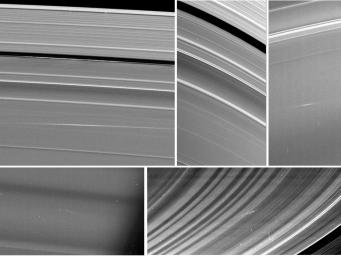Meteors Meet Saturn’s Rings
Caption:
Five images of Saturn's rings, taken by NASA's Cassini spacecraft between 2009 and 2012, show clouds of material ejected from impacts of small objects into the rings. Clockwise from top left are two views of one cloud in the A ring, taken 24.5 hours apart, a cloud in the C ring, one in the B ring, and another in the C ring. Arrows in the annotated version point to the cloud structures, which spread out at visibly different angles than the surrounding ring features.
The clouds of ejected material were visible because of the angle sunlight was hitting the Saturn system and the position of the spacecraft. The first four images were taken near the time of Saturn equinox, when sunlight strikes the rings at very shallow angles, nearly directly edge-on. During Saturn equinox, which occurs only every 14.5 Earth years, the ejecta clouds were caught in sunlight because they were elevated out of the ring plane. The last image was taken in 2012 at a very high-phase angle, which is the sun-Saturn-spacecraft angle. This geometry enabled Cassini to see the clouds of dust-sized particles in the same way that dust on a surface is easier to see when the viewer is looking toward a light source.
The angle that the clouds are canted gives the time elapsed since the cloud was formed (see
PIA14941
). The A ring cloud formed 24 hours before its first apparition in the top left box; it formed 48.5 hours before the top middle image. The other three clouds were approximately 13 hours, four hours, and one hour old (respectively) at the times they were seen. See
PIA11674
for more information on ring impacts.
Background Info:
The Cassini-Huygens mission is a cooperative project of NASA, the European Space Agency and the Italian Space Agency. The Jet Propulsion Laboratory, a division of the California Institute of Technology in Pasadena, manages the mission for NASA's Science Mission Directorate, Washington, D.C. The Cassini orbiter and its two onboard cameras were designed, developed and assembled at JPL. The imaging operations center is based at the Space Science Institute in Boulder, Colo.
For more information about the Cassini-Huygens mission visit
http://saturn.jpl.nasa.gov
. The Cassini imaging team homepage is at
http://ciclops.org
.
Cataloging Keywords:
| Name |
Value |
Additional Values |
| Target |
Saturn Rings |
A Ring, Saturn |
| System |
Saturn |
|
| Target Type |
Ring |
Planet |
| Mission |
Cassini-Huygens |
|
| Instrument Host |
Cassini Orbiter |
|
| Host Type |
Orbiter |
|
| Instrument |
Imaging Science Subsystem (ISS) |
|
| Detector |
|
|
| Extra Keywords |
Disk, Dust, Grayscale, Impact |
| Acquisition Date |
|
| Release Date |
2013-04-25 |
| Date in Caption |
|
|
| Image Credit |
NASA/JPL-Caltech/Space Science Institute/Cornell |
| Source |
photojournal.jpl.nasa.gov/catalog/PIA14938 |
| Identifier |
PIA14938 |

 Planetary Data System
Planetary Data System
